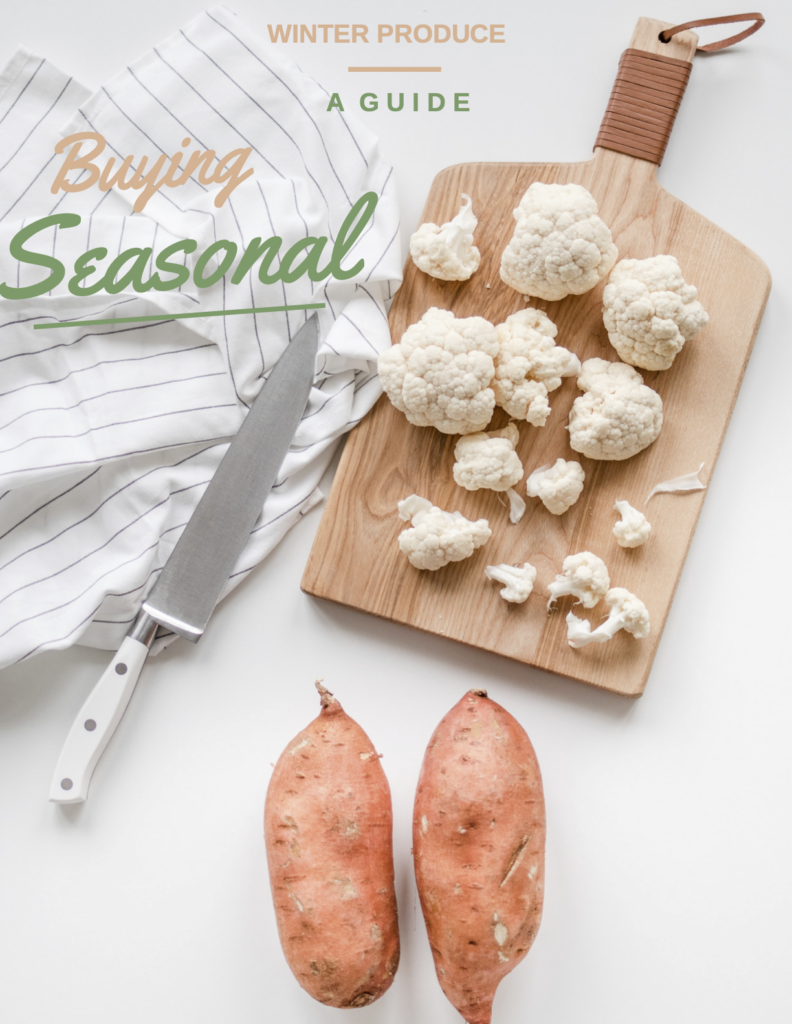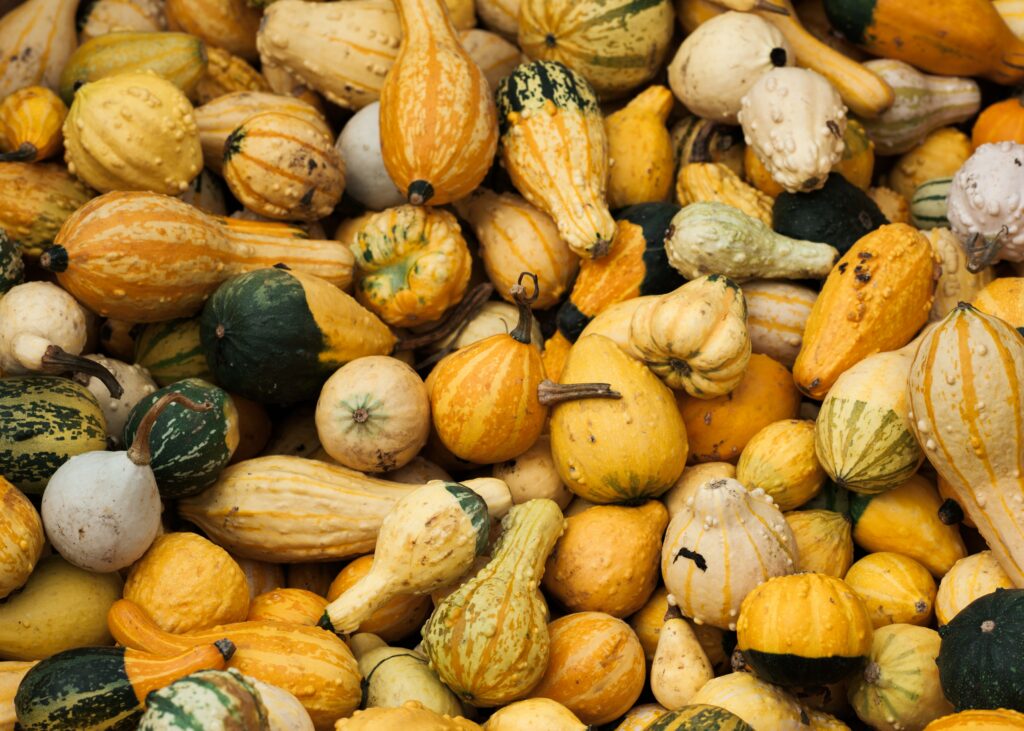With February underway, it’s time to focus on a new phase of nourishment: winter produce. This month, focus on warming the body from the inside out. With the rush of January behind us, February beckons an opportunity to slow down—to get back to the basics. In ancient times, this season lured humanity into the comfort of their dwellings. Hours were spent in front of a fire, reading and reflecting. In many ways, it’s no surprise that winter is about self-examination. It’s an opportune time to lean into change and dream up new ideas. Speaking of, let’s dive into what fruits and vegetables are in season right now—and the best Ayurvedic foods in winter for digestion. Hopefully, you’ll be inspired to add more creativity and variety to your plate.

WHAT IS AYURVEDA?
Ayurveda is a natural system of medicine. Originating in India more than 3,000 years ago, Ayurveda is derived from the Sanskrit words ayur (life) and veda (science or knowledge). Thus, Ayurveda translates to knowledge of life. To this day, Ayurvedic medicine is widely used for its focus on whole-body healing. According to Ayurveda, an imbalanced dosha leads to poor health and disease. Therefore, opting for food, exercise, and lifestyle habits based on your dosha is believed to promote optimal health and balance.
Ayurvedic Winter Diet
Thanks to this season’s cold and dry atmosphere, both our external and internal bodies become dry. Other than staying hydrated with mineral-rich water, Ayurveda encourages Kapha foods. These are warm and oily. Ironically, diet culture promotes raw foods and smoothies as a post-holiday detox, but Ayurveda encourages the opposite. Instead of a mid-day salad, nourish your body with warm, cooked foods. Incorporate extra-virgin olive oil, coconut oil, and ghee. Rather than sip on iced drinks, start your mornings off with a comforting tea, rich in spices like ginger, cinnamon, tulsi, cardamom, and clove. Additionally, soups, dahls, and stews are hearty and healthy meals for winter.

PRIORITIZE YOUR GUT HEALTH
Because the bacteria in your gut influences the health of your entire body, it’s important to have a healthy microbiome—especially in the winter. Generally speaking, an optimal gut is a diverse gut. The more species of bacteria you have, the more health rewards you reap. So, how to improve your gut health? In part, by letting an Ayurvedic winter produce guide fill your grocery basket.
EAT A DIVERSE ARRAY OF COOKED FOODS
This includes produce rich in fiber and antioxidants, like beets and broccolini. In essence, the process of cooking food breaks down some of its fibers and plant cell walls, making it easier for the body to digest and absorb the nutrients.
PRIORITIZE THE MEDITERRANEAN DIET
There are a variety of reasons to eat like the Mediterraneans do. But mainly because of its emphasis on vegetables, fruits, beans, and legumes. These are high-fiber, gut-friendly foods that promote the growth of beneficial bacteria. A diverse diet—ideally, with minimal industrial seed oils—can lead to a more diverse microbiome, which is beneficial for your health.
CHOOSE FERMENTED FOODS
Fermented foods, like plain yogurt, kimchi, and tempeh can benefit the microbiome. They enhance its function and reduce the abundance of disease-causing bacteria in the intestines.
ADD IN PREBIOTICS
Many fruits, vegetables, and whole grains contain prebiotics, but they can also be found on their own. Resistant starch (like an unripe banana) can also be a prebiotic. If eating an unripe banana sounds unappetizing, you can also benefit from prebiotics by eating cooked and cooled potatoes and rice. The cooling process turns some of the digestible starches into resistant starches.
CONSUME PROBIOTICS
Beyond probiotic-rich foods, opt for a probiotic supplement. In essence, probiotics are often referred to as the “good”—or “helpful”—bacteria. They help keep your gut humming along. In addition to supporting digestive health, probiotics can also help with overall immune function.
LIMIT SUGAR
This is easier said than done, but the goal is to keep blood sugar balanced. After all, chronically elevated glucose levels can reduce beneficial bacteria. When it comes to baking holiday cookies and pies, consider swapping common sources of sugar for their lower-glycemic alternatives.

Tips for eating healthy in the winter
When it comes to eating healthy in the winter, focus on supporting your immune system and keeping blood sugar balanced. How to do this? Eat root vegetables and whole grains, stewed berries, and warming herbs like ginger and cinnamon (which are loaded with antioxidants). Getting adequate protein is key, too. Overall, think Mediterranean diet. Furthermore, aim to keep blood sugar balanced. When making your meals, aim for half a plate of non-starchy veggies, 4-6oz protein, 1-2 sources of healthy fats, and 1/2-1 serving of complex carbs. So, this might look like spinach and leeks sautéed in ghee, a filet of roasted fish drizzled in olive oil, and one serving of basmati rice.
What Foods Should You Eat In February?
According to traditional Chinese medicine, eating seasonally and locally is key. With that in mind, here are micro and macronutrients to focus on throughout the winter:
Fruit: dates, figs, kiwi, tangerines, cooked apples, apricots, and lemons
Green veggies: cooked spinach, asparagus, Brussels sprouts, and kale
Root veggies: onions, leeks, winter squash, pumpkin, turnips, potatoes, and sweet potatoes
Whole grains: rice, buckwheat, rye, amaranth, and oats
Healthy fats: macadamia nuts, walnuts, cashews, pistachios, pumpkin seeds, ghee, butter, soft cheeses, cottage cheese, warm milk, flaxseed oil, and olive oil
Legumes: brown and red lentils, tofu, tempeh, and miso
Meat: beef, chicken, lamb, and venison
Herbs: ginger, turmeric, cinnamon, cloves, and black pepper

what are Root Vegetables?
Helping you align with Ayurveda’s winter season, consider incorporating as many root vegetables as possible. Root vegetables are great for grounding because they (quite literally) grow underground. As their name suggests, root vegetables have roots that extend deep down within the earth. These roots anchor the plant in place, providing a strong foundation for their growth. Sweet potatoes, carrots, turnips, onions, parsnips, turnips, garlic, radishes, and rutabagas are examples of root vegetables. These can all be cooked in warm dishes throughout the fall and winter seasons, aiding in satiation and energy.

Winter Produce guide
A wonderful repertoire of colors, tastes, and textures, there is a variety of fruits and veggies in season in the winter to add to your grocery cart. Below, you’ll find 10 fruits and vegetables in season in winter and delicious recipes to cook with them.
Beets
Beet Salad with Goat Cheese and Balsamic by Love & Lemons. This beet salad recipe is a stunning fall or winter side dish. Goat cheese, apples, and arugula fill it with a delightful mix of textures and flavors.
Brussels Sprouts
Roasted Brussels Sprouts by Downshiftology. These Brussels sprouts are addictively crunchy and the perfect side dish for almost any occasion. Roasting the Brussels sprouts in the oven turns them crispy on the outside, tender on the inside, and brings out their subtle sweetness.
Celery
Shaved Fennel and Celery Salad by Platings + Pairings. This fennel and celery salad comes together quickly and has such a delicious light lemon vinaigrette and wonderful crunch. It’s the perfect side salad for rich and hearty dishes like pasta or braised short ribs.
Collard Greens
Vegan Collard Greens by Real and Vibrant. These vegan collard greens are simple enough for a weeknight meal but have enough flavor to serve to guests or as a holiday dish. You can whip up this tasty side dish in less than 30 minutes.
Grapefruit
Grapefruit Yogurt Cake by Life is But a Dish. A simple yet flavorful cake with notes of grapefruit. Perfect for a holiday brunch.
Kale
Fall Harvest Honeycrisp Apple and Kale Salad by Half-Baked Harvest. Tossed with a caramelized shallot vinaigrette, this salad will become a dinnertime staple. It’s nourishing, delicious, and incorporates beautiful winter produce.
Kiwi
Winter Fruit Salad by Love To Be In The Kitchen. This winter fruit salad is a colorful dish to brighten up any holiday meal or party. Fresh pineapple, kiwi, mandarin oranges, apple, pear, and pomegranate arils are tossed in a honey-lime poppy seed dressing.
Leeks
Healthy Tomato Basil Soup by Wellness with Edie. This creamy tomato basil soup is hearty, sweet, and savory. It’s easy to make, and it tastes even more delicious the next day. Pair it with a toasted sandwich or sliced baguette. It’s naturally gluten-free and vegetarian.
Potatoes
Garlic Herb Smashed Potatoes by Joyful Healthy Eats. These delicious potatoes are crispy on the outside and soft on the inside. It’s an easy appetizer recipe that’s filled with fresh garlic and herb flavor.
Winter Squash
Walnut Sage Pesto Pasta with Roasted Delicata Squash by A Beautiful Plate. Whole wheat pasta is tossed with homemade walnut-sage pesto and topped with roasted delicata squash. This vegetarian pasta recipe is perfect. It comes together quickly, but is elegant enough to be served for special occasions.
Images courtesy of Unsplash.



Leave a Reply